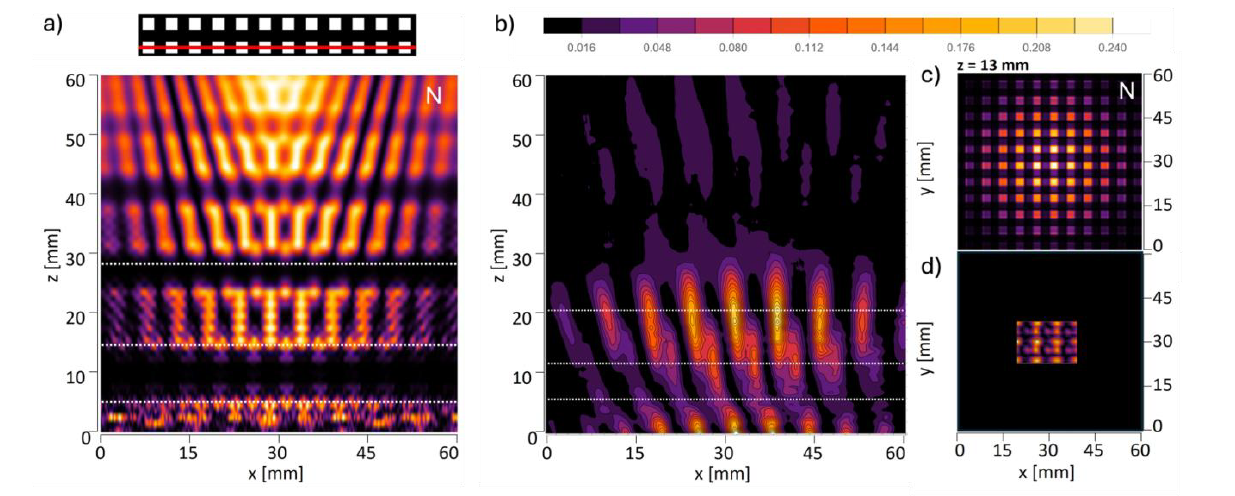| PREVIOUS PRESENTATION | BACK TO PROGRAM OVERVIEW | NEXT PRESENTATION |
Self-imaging effect at terahertz frequencies with sub-wavelength resolution
Adrianna Nieradka1, Mateusz Kaluza1, Paweł Komorowski2, Przemysław Zagrajek2, and Agnieszka Siemion1
1Faculty of Physics, Warsaw University of Technology, Koszykowa 75, 00-662 Warsaw, Poland
2Institute of Optoelectronics, Military University of Technology, gen. S. Kaliskiego 2, 00-908 Warsaw, Poland
Terahertz (THz) radiation exhibits unique properties in comparison to long-utilized microwave radiation or visible light. Therefore, various diffractive effects described and observed for the optical range of radiation are nontrivial to be transferred and demonstrated in THz and sub-THz wavelengths. One such effect is self-imaging or the Talbot effect [1]. It manifests in the presence of the self-images of the periodical object behind it. They are formed at Talbot distances and look like the input object. Moreover, the fractional Talbot effect can also be observed at closer distances, forming with basic images a light field distribution named Talbot carpet. In the case of THz radiation, the period of the mask is often in the order of the wavelength, which brings us almost to an approach where one should use the effective refractive index. Next, the diameter of the illuminating beam allows to cover a very limited number of full periods within the working aperture of the THz optical system, which means that we have a quasi-periodic object (small number of repetitions), which affects the self-imaging phenomenon [2]. Moreover, sub-wavelength probing is necessary to image the fast-changing patterns (in relation to the wavelength). Here, an alternative method using a dielectric waveguide to achieve better sampling resolution was proposed. It allowed for detailed scanning of terahertz light field distributions after passing the sample. As a waveguide, a filament from cyclic olefin copolymer (COC) was chosen as one of the most transparent 3D printing materials in the THz range. In this work, the self-imaging phenomenon has been demonstrated at sub-THz frequencies (here 100 GHz). The opaque masks with transparent square holes distributed in a rectangular matrix have been fabricated using 3D printing. The masks have been illuminated with a divergent Gaussian-like beam, and the space close behind the masks has been probed with a 1.75 mm polymer waveguide to achieve high-resolution scanning. The comparison of simulated and experimental results is shown in Fig. 1.

Figure 1: Intensity distributions corresponding to Talbot carpets and their cross-sections at half-Talbot distance. a) The simulated xz intensity distribution observed behind the quasi-periodic structure having 6 mm period illuminated with Gaussian type beam. White dotted lines indicate the distance corresponding to the quarter-, half-, and full-Talbot distance. b) The experimental intensity pattern registered after the periodic object in the form of Talbot carpet. White dotted lines indicate the distance of performing xy scan in the experimental evaluation. c) The simulated xy light field distribution corresponding to half-Talbot distance. d) The experimental intensity pattern recorded at the distance corresponding to half-Talbot distance. The scans were performed with the waveguide method behind the d = 6 mm mask. The colorbar at top right represents the intensity scale for the experimental data, numerical simulations were normalized (which is denoted with white “N” letter in the intensity distributions).
As can be seen in Fig. 1, the details of the Talbot-like carpet are very prominent and stay in accordance with simulation results. The proposed scanning method allowed to register the intensity pattern at very close distances behind the periodic mask. It is crucial because a very near field can be observed, which will help to develop a proper theoretical description — discussing the self-imaging properties in the zone where distances are close to the wavelength.
This work served two purposes. Firstly, it successfully demonstrated the Talbot effect in sub-THz frequencies. Secondly, the sub-wavelength THz scanning system has been implemented, allowing for the probing of the THz radiation patterns with a resolution better than the dimensions of the detector’s aperture.
Acknowledgments
The research was partially funded by the OPUS-18 program (2019/35/B/ST7/03909) by National Science Centre, Poland.
References
[1] H. F. Talbot. “LXXVI. Facts relating to optical science. No. IV,” The London, Edinburgh, and Dublin Philosophical Magazine and Journal of Science. 9(56), 401-407 (1836)
[2] J. F. Barrera, R. Henao, Z. Jaroszewicz, A. Kolodziejczyk, “Talbot effect for periodical objects limited by finite apertures: a new interpretation,” Optik 116(3), 144-148 (2005)
